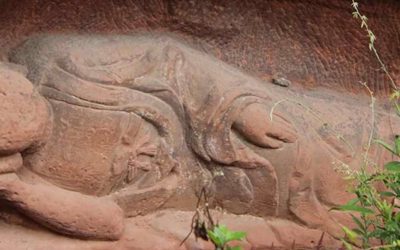Manual of Taoist Architecture
There are some illustrated books that produce in the reader a contradictory feeling, because the images that explain what the text is about are sometimes accompanied by an exposition of ideas that is too superficial. Therefore the reader does not know whether to focus on images that are beautiful or on a text that does not end up filling all his curiosity about the subject. In this book no, perhaps because of the breadth of its subject and the originality of it, no one can expect to delve into each of the issues to be touched, so that this generalizing character accompanied by an impressive number of photos, most very significant and very important for the understanding of the text, makes just the subject it deals with, the Taoist architecture, is shown in its most basic aspects.
The book consists of four parts. The first is a general introduction, which is devoted to describing once again the beginning of Taoism, its fundamental principles, its theology and faith, the system of deities and immortals, and the miracles that appear in this religion. Although it is a somewhat cursory pass through these matters, I think it is described quite accurately and precisely responds to the reader’s desire to know a little about the religion that the book is going to deal with.
“Taoism represents a positive and optimistic philosophy of life. Being alive is a pleasure, longevity and immortality its goals as long as one follows the principles of Taoism, avoids harming one’s own vital energy by rejecting human emotions and the desires of this world, by achieving harmony, these goals can be achieved” (page 25).
“The three pure ones are their highest deities. they have four assistants, the most important of which is the Jade Emperor. one of these assistants is female and is in charge of governing procreation, the earth, the mountains and the rivers” (page 26).
“For them the human body is a universe in itself, with a series of deities that are similar to those that exist outside the body. Through the spirits inside people’s bodies, the gods are informed of their good and bad deeds” (p. 27).
The second chapter, which is possibly the most interesting, is also the shortest, since it is a vision of Taoist architecture. It attempts to show the main rules that were followed in the design of the temples of this religion, including the architectural design, the selection of the site, the arrangement of its wings, and the structure of the temple itself.
- “Taoist buildings are places where priests offer sacrifices to deities, practice asceticism, pray, and perform ceremonies. As Taoism developed, the architecture of its buildings grew and became more varied.”
- “Taoist architecture is basically traditional Chinese architecture based on a four-sided courtyard, with the main halls arranged along a central axis for the statues of the deities to be placed on an altar and for ceremonies and prayers to be performed. The lesser halls, such as the memorial halls, the refectory or the rooms, were less strictly arranged along auxiliary axes on the two sides, and parallel to the central axis. Many of the monasteries had gardens, especially located at the back of the central axis, especially in the mountainous regions, where they were sometimes of spectacular beauty.”
The third chapter is already more limited to those who have a particular interest in the sites of the main Taoist temples, because it makes a little deeper description, not much, maybe two or three pages, of some of the most important temples of the Taoist tradition, explaining something of its origin of its formation and showing some pictures of its most important halls.
The fourth part, which is almost half of the work, is simply called «Notes on the photographs» and I think it is a very beautiful catalog of some of the most beautiful temples and halls of Chinese Taoism. In many of the cases there are architectural plans not only of the building itself but also of the general distribution in the mountain or in the environment where it was built in other cases we find some details, such as the frescoes of the Daimiao temple in Taian, in others simply of its external appearance or the environment in which they were built.
In short, the book as a whole clearly shows that introduction to the objective that was proposed and I think it is a very interesting addition to the library of all those interested in Chinese culture, architecture and Taoism.
Qiao Yun. Taoist Buildings. Buildings of the Indigenous religion of China. China Architecture & Building Press. 2012.
Last posts
Buddhist Immersion from Shanghai: No Need to Board a Plane—Paradise Is Right at Your Doorstep
Buddhist Immersion from Shanghai: No Need to Board a Plane—Paradise Is Right at Your Doorstep Residents of Shanghai eager to learn more about Buddhist art and history often think they must undertake long journeys to reach the sacred mountains of this religion. What...
The Lost Mythology of Ancient China
The Lost Mythology of Ancient China Reconstructing the mythology of ancient China is a painstaking task that tries to characterize some legendary figures and situations based only on the few sentences about them found in later works by philosophers and historians. The...
How a Eunuch Was Created in 19th-Century China
How a Eunuch Was Created in 19th-Century China A wealthy eunuch would purchase a boy from a poor family. This boy had to be between seven and ten years old. He would be kept confined for two weeks and subjected to a very strict diet; he ate little. Use of...







